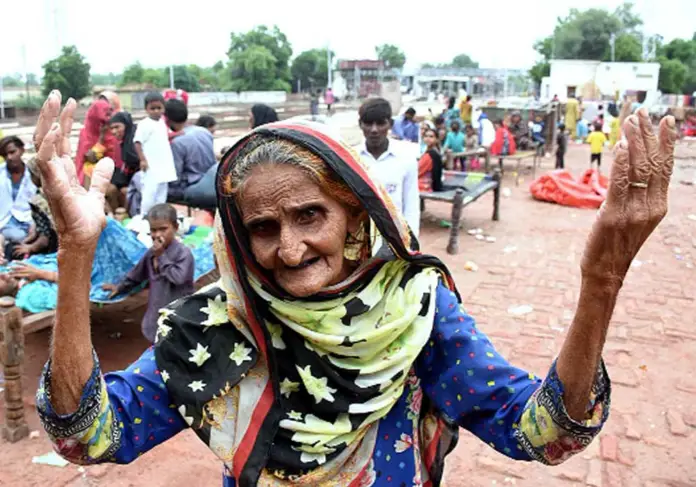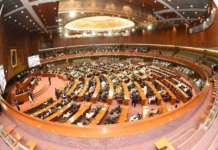Waterborne diseases continue to push the death toll up in the flood-hit areas, as another 37 people died of various infections and flood-related incidents in the last 24 hours, taking the death toll from the catastrophe to 1,545.
According to data released by the National Disaster Management Authority (NDMA), during the past 24 hours, 32 people perished in Sindh and five in Balochistan.
Moreover, at least 92 individuals were injured during the same time period, including 91 in Sindh and one in Gilgit-Baltistan, taking the total number of injured to 12,850. The NDMA report added that as many as 104,072 houses were damaged during the previous day and at least 8,252 heads of cattle were killed in flood-related incidents.
According to reports, four members of a family were killed when the roof of their damaged house collapsed in village Mohammad Siddiq Lakho near Kandiaro town of Naushahro Feroze. The victims were identified as Abdul Rehman, Mohammad Saleem, Mohammad Qasim and Mohmmad Ashiq.
The villagers, after hectic efforts, pulled the bodies out of the rubble and desperately tried to shift the injured to nearby health unit, but they could not do it timely due to floodwaters. However, villagers saved the life of one man who also sustained injuries in the incident.
According to unofficial reports, as many as 17 people died due to the outbreak of various diseases in different areas of the province.
Also, there were reports that two people died of dengue, while four people also drowned in parts of Sindh. Earlier this week, the country feared that floods might have caused over $40 billion in economic losses and damages, as the National Flood Response Coordination Centre (NFRCC) dismissed initial assessments of $18 billion.
The $40 billion losses were flagged in a flood response centre meeting during a discussion on an interim report titled “An Early Assessment of Flood Impact on Pakistan’s Economy”, presented by the Ministry of Finance. Planning Minister Ahsan Iqbal heads the NFRCC – a joint civil-military body set up to monitor and coordinate relief and rehabilitation work.
“The devastating conditions suggest that the scale of flood losses is in the range of $30 billion to over $40 billion,” Iqbal said.
It is for the first time that the $40 billion loss estimate has been given, which is three times the initial estimate of $10 billion to $12 billion. The new number is even far higher than the $30 billion figure given by United Nations Secretary-General Antonio Guterres last week. The floods have displaced hundreds of thousands of people in Sindh, where water levels have started dropping in recent days albeit gradually. Officials estimate that it may take two to six months before floodwaters recede completely.
On Saturday, Mehar Assistant Commissioner (AC) Mohsin Sheikh said that the water level had dropped approximately by three feet at the ring bund and expressed the hope that the floodwater would recede completely from there within three days. Meanwhile, water was standing up to eight feet in Mehar’s villages, he said.
In Khairpur Nathan Shah city, Assistant Commissioner Sonu Khan Chandio said the water level had dropped approximately by three feet. In the region’s remote areas, he added, the stagnant water was as high as “eight to nine feet”.
Johi Assistant Commissioner Muhammad Ali Baloch estimated that water had dropped by around three feet in the region’s outskirts.
Similarly, Dadu Assistant Commissioner Shahnawaz Merani said that the water was now flowing back into Manchar Lake from the city’s remote areas. He said tent cities were being established in Dadu city to house flood-affected individuals and families.
In Bhan Saeedabad, MNA Sikandar Ali Rahoupoto said the water was continuously receding in the city and its outskirts and there was no pressure on the city’s ring bund. “The water is standing up to eight to nine feet in Bhan Syedabad, which is continuously dropping. Life has returned to Bhan Saeedabad,” he said.
Meanwhile, an engineer of the provincial irrigation department, Mahesh Kumar, said the water level in Manchar Lake was measured at 121.2-foot reduced level around noon on Saturday. “The water from the lake is now flowing in the Indus River,” he said.
On Saturday afternoon, the Indus was witnessing a medium-level flood at Kotri, according to the Flood Forecasting Division’s website. On the other hand, fear gripped rain-hit villagers when a seven-foot-long crocodile surfaced in stagnant floodwater in village Muhammad Yousuf Dahri near Jamsahib, a few kilometers from Nawabshah. The villagers immediately informed the Wildlife Department, and its team rushed to the site. Later, after hectic efforts, the crocodile was captured.







